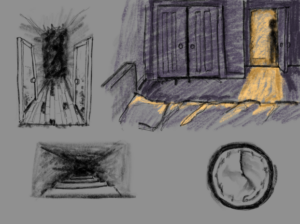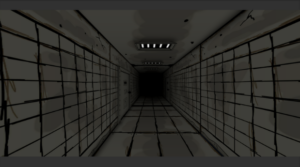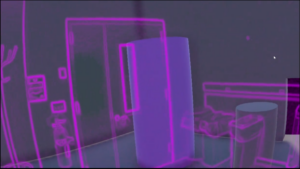
This week our team focused on creating prototypes to explore our technical and artistic ideas. We also continued to explore questions about what makes our experience unique. This focus came from our instructor meeting this week, which was about preparing for 1/4s. Since our project is focused on Discovery rather than Delivery, Ricardo encouraged us to explore many ideas quickly, rather than already focusing down on creating a single demo for 1/4s. By creating multiple small demos to showcase together, it would be easier to convey the breadth of ideas we had explored so far. He also encouraged us to discover what made our experience of a dream based on fear different than a traditional horror game. This led us to get more specific about what we mean by “fear.” Rather than an experience about jump scares, we want players to experience the feeling of dread, and being continually stuck in and surrounded by something that causes it.

On the art side, our team continued generating concept art based on our research and surveys. We discussed how people’s dreams generally cannot be composed of entirely new images, but instead are remixes of things people have seen in real life. This concept guided us to keep our environment concepts relatively realistic. We believe that this idea, when combined with the lack of object permanence we started exploring last week, will give our experience the “dreamlike” visual identity we want. We also explored different possible overall art styles, including ones inspired by sketchbooks, and by the graphics of the PlayStation 1. By the end of the week we had a first 3D environment of a dark hallway, rendered in the style of a pencil sketch. We decided to light the hallway in a blue-white color that both reflected the reality of fluorescent lights and suggested the depths of the ocean, which was mentioned repeatedly in our fear surveys.

On the technical side, we took our two demos from last week and combined them into one that procedurally lays out 3 of our gaze demo rooms in a random arrangement. We also got started on creating a movement system, and discussed whether free movement or teleportation are a better fit for our VR experience. We created demos exploring if and how the Quest 2’s passthrough camera could add to our experience, perhaps by allowing the “waking world” to intrude in behind or in front of objects in our virtual dream world.
Finally, we discussed possible designs for the mechanics and objectives of our experience. We looked back at our surveys for actions people had mentioned that could be translated into game objectives. There were repeated mentions of running from fears, hiding, exploring endless expanses, and being forced to face something you didn’t want to see or experience. From here, we talked about the idea of structuring our dream as a series of scenes that explore one aspect of fear, and guiding the user toward a clear action (such as “hide” or “search”) that will allow them to progress past this part of their dream. These actions could make the user feel as though they are facing their fears or as if they are avoiding them, depending on what feeling we want to emphasize.
Moving into 1/4s next week, we are looking forward to showing our tech and art demos to the faculty. In the beginning of next week we will prepare both our presentation and our specific questions for faculty that we hope will guide us toward helpful feedback on the unanswered question of our project.
